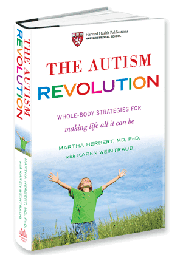Here are some goals of different kinds of treatments. The underlying views motivating each of these goals have critics.
Note: The narrative on this page is still in process of being written.
- Elimination or suppression of symptoms and challenging behaviors
- probable underlying view: Autism is behavioral in nature and training can reduce aberrant behaviors.
- critique: Autism is behavioral but much more.
- toward higher synthesis: How do you address behavioral issues skillfully while understanding that they can be driven or made worse by problems at other levels (like physical illness, sleep deprivation, pain, allergies, sensory overload, inadequately targeted pedagogy, etc.)?
- Fixing neurological pathways through molecular intervention
- probable underlying view: neurological problems are based in genetically caused molecular defects that may eventually be repaired or compensated for by carefully targeted pharmaceutical interventions carefully targeted at specific molecular targets
- critique: neurological problems can be rooted in genetic but also in environmental challenges. It may be harder to find precisely targeted molecular targets for environmental insults to molecular mechanisms.
- toward higher synthesis: integrating molecular understanding and intervention at the level of biochemistry and pathophysiology (including low-risk nutritional measures) may help build metabolic resiliency so the mechanisms impaired by toxic or other environmental insult can start working better. This will reduce the likelihood that molecular intervention efficacy will be reduced by the ways environmental insults make the situation substantially worse.
- Removal of obstacles
- probable underlying viewpoint: autism involves pathophysiological processes that obstruct underlying circuitry from its full functionality
- Provision of supports
- Normalcy
- probable underlying viewpoint: autism is a disorder defined by abnormal behaviors and the preferred state is being normal
- Basic adaptive skills
- probable underlying view: autism involves impairment and difficulty with skills important in everyday life. These skills can be built by intensive training.
- Communication skills
- probable underlying belief: difficulties with communication are frustrating and get in the way of getting needs met and sharing with the world and getting more skills is a good idea
- Social skills building
- probable underlying belief: social skills do not come as “naturally” to people with autism as they do to neurotypcial individuals, but they can be trained with careful and persistent effort.
- Resiliency
- probable underlying viewpoint: autism can involve vulnerability at every level from cell and organ health to brain function, sensory threshold and emotional and social interaction. Better health and more skills create a “buffer” to protect against being kicked around by circumstances.
- Maximal options
- probable underlying viewpoint: The problem with so-called “impairments” is that they cut down on your options, and having more options gives more freedom.
- Being extraordinary
- probable underlying viewpoint: people with autism have unusual and extraordinary capabilities and with nurturance, support and rich learning opportunities may find rich ways of expressing and manifesting these.


